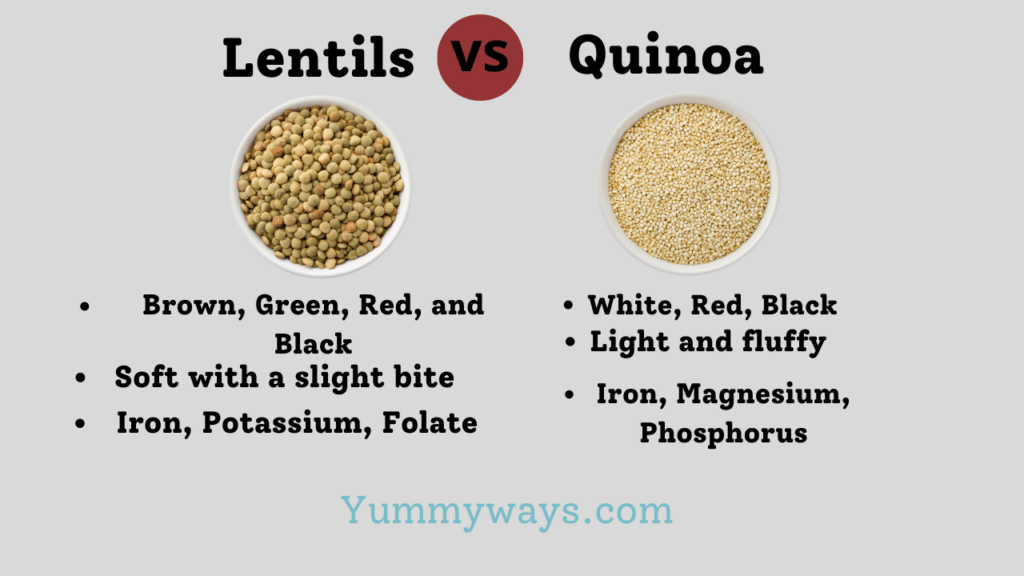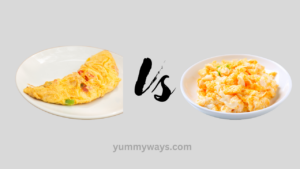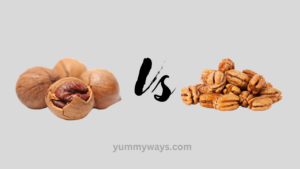Lentils are one kind of edible legume from the plant family called Fabaceae. They are tiny, lens-shaped seeds in various colors, including brown, green, red, and yellow. On the other hand, Quinoa is a grain-like crop considered a pseudocereal because it is not an actual grass like wheat or rice. Quinoa seeds are small, round and come in various colors, including white, red, and black. I have found nutritional differences among them as prominent.
But there are some differences also. I have covered the differences in tastes, health, nutrition, and cooking and some similarities. You must read the full article to know all the differences between Lentils and Quinoa.

Contents
- 1 What are Lentils?
- 2 What is Quinoa?
- 3 Overview of Lentils vs Quinoa
- 4 Detailed Differences Between Lentils and Quinoa
- 5 Which One is Better?
- 6 conclusion
- 6.1 How do lentils and quinoa differ in terms of nutritional value?
- 6.2 What are the culinary uses of lentils and quinoa?
- 6.3 Are lentils and quinoa suitable for special diets, such as vegetarian, vegan, or gluten-free diets?
- 6.4 Which one, lentils or quinoa, is easier and quicker to cook?
- 6.5 Are there any potential allergenic concerns associated with lentils or quinoa?
- 6.6 Can lentils and quinoa be used together in recipes?
- 6.7 Can lentils and quinoa be stored for a long time?
What are Lentils?
Lentils are edible legumes. They are consumed worldwide for their nutritional value. They are small, lens-shaped with various colors, including brown, green, red, and black. Also Read: Acorn vs Chestnut: Which One is the Better Nut
What is Quinoa?
Quinoa is a highly nutritious grain. It gained popularity because of its various health benefits and versatility in cooking. It is often referred to as a grain. Quinoa is a seed and belongs to the same family as spinach and beets. It originated from the Andean region of South America, even been cultivated in Peru, Bolivia, and Ecuador for thousands of years. It was considered a sacred staple food by the ancient Incas.
Overview of Lentils vs Quinoa
Look at the short key points regarding the differences between lentils and quinoa. It will give you a quick overview of the differences.
| Aspect | Lentils | Quinoa |
| Source | Legumes (Lens culinaris plant) | Seed (Chenopodium quinoa plant) |
| Classification | Legume | Pseudo-cereal |
| Colours | Brown, Green, Red, and Black | White, Red, Black |
| Protein Content | High | High |
| Fibre Content | High | High |
| Amino Acids | Incomplete protein | Complete protein |
| Cooking Time | Longer cooking time (20-45 minutes) | Shorter cooking time (15 minutes) |
| Texture | Soft with a slight bite | Light and fluffy |
| Gluten-Free | Yes | Yes |
| Culinary Uses | Soups, stews, curries, side dishes | Salads, pilafs, stir-fries, baking |
| Key Nutrients | Iron, Potassium, Folate | Iron, Magnesium, Phosphorus |
| Dietary Benefits | Plant-based protein, Fiber | A complete protein, Fiber |
Detailed Differences Between Lentils and Quinoa
Source and Classification
Lentils are legumes and seeds from the Lens culinaris plant. They are in various colors, such as brown, green, and red. Quinoa is a seed from the Chenopodium quinoa plant. It is classified as a pseudo-cereal.
Nutritional Profile
Lentils and quinoa have different nutritional compositions. Lentils are high in protein and dietary fiber. For this reason, it’s a great source of plant-based protein and aids digestion. They are also rich in minerals like iron, potassium, and folate. On the other hand, Quinoa is also a complete protein source. That means it contains all essential amino acids. It is also high in dietary fiber, iron, magnesium, and phosphorus. Also Read: Beets vs Turnips: A Comprehensive Comparison
Cooking Time and Texture
Lentils require longer cooking times compared to quinoa. Depending on the variety, they can cook for 20-45 minutes. They have a soft texture with a slight bite and absorb flavors well. For this reason, they are ideal for soups, stews, and curries. Quinoa cooks quickly in about 15 minutes and has a light, fluffy texture. It has a mild, nutty flavor and is used as a base for salads, pilafs, and other dishes.
Gluten Content
Lentils are naturally gluten-free. Because of that, they are suitable for individuals with gluten intolerance or celiac disease. On the other hand, Quinoa is also gluten-free and an excellent alternative for those with gluten sensitivity.
Culinary Uses
Lentils and quinoa have different culinary applications. Lentils are used in soups, stews, curries, and side dishes. They are pureed into dips or used as a meat substitute in vegetarian dishes. On the other hand, Quinoa is versatile and used as a grain substitute. It serves as a base for salads, pilafs, and stir-fries. And it is also ground into flour for baking purposes.
Which One is Better?
I have told you about the basic differences in the above sections of the discussion. You might get a clear idea of which will be better for you. But let’s discuss that again in more specific detail.
Lentils and quinoa are both highly nutritious foods that offer several health benefits. The choice between them depends on your preferences and dietary needs. What do I like best about lentils and quinoa? Here’s some information about each to help you make an informed decision.
Lentils have low in fat and calories. For this reason, It’s a great choice for weight management. They have a mild, earthy flavor and a versatile texture. On the other hand, Quinoa is a seed often referred to as a pseudocereal. Because it is prepared and consumed similarly to grains. It is a complete protein source, containing all nine essential amino acids the body needs.
Finally, the choice between lentils and quinoa depends on your dietary preferences and needs. Lentils are an excellent choice if you’re looking for a protein-rich option with a wide range of culinary uses. On the other hand, if you prefer a gluten-free, complete protein source with a unique texture and versatility, quinoa is more suitable. Both lentils and quinoa are incorporated into a balanced diet to provide essential nutrients and contribute to overall health.
conclusion
Both lentils and quinoa offer numerous health benefits and valuable additions to a balanced diet. Lentils are cost-effective and easily accessible, while quinoa provides a complete protein source and a unique taste. Consider your preferences, dietary restrictions, and culinary needs when choosing between the two. Incorporating both lentils and quinoa into your meals for a diverse nutrient profile is beneficial.
How do lentils and quinoa differ in terms of nutritional value?
Lentils and quinoa offer different nutritional profiles. Lentils are an excellent source of plant-based protein, dietary fiber, folate, iron, and other minerals. They are low in fat and rich in complex carbohydrates. On the other hand, Quinoa is also high in protein and dietary fiber. It is a complete protein source containing all essential amino acids. Quinoa is also a good source of iron, magnesium, and phosphorus.
What are the culinary uses of lentils and quinoa?
Lentils and quinoa are versatile ingredients used in a variety of culinary dishes. Lentils are used in soups, stews, salads, curries, and vegetarian/vegan patties. They are cooked quickly and easily, and their mild flavor allows them to absorb other flavors. Quinoa is often cooked and used as a grain substitute in salads, pilafs, stir-fries, and as a side dish. It has a nutty flavor and a slightly crunchy texture.
Are lentils and quinoa suitable for special diets, such as vegetarian, vegan, or gluten-free diets?
Both lentils and quinoa are highly suitable for vegetarian and vegan diets, as they provide plant-based protein and other essential nutrients. Lentils are gluten-free, making them a good option for gluten-free diets. Quinoa is also gluten-free and is often used as a substitute for gluten-containing grains in gluten-free recipes.
Which one, lentils or quinoa, is easier and quicker to cook?
Lentils are generally easier and quicker to cook compared to quinoa. Depending on the variety, lentils can be cooked in about 20-30 minutes, while some quinoa require 15-20 minutes. However, pre-soaking lentils can help reduce the cooking time further.
Are there any potential allergenic concerns associated with lentils or quinoa?
Allergies to lentils are relatively rare but can occur. Individuals with legume allergies should exercise caution when consuming lentils. Quinoa is considered a low-allergenic food, and allergic reactions are uncommon. However, individuals with a known sensitivity to quinoa or related plants should avoid it.
Can lentils and quinoa be used together in recipes?
Lentils and quinoa can be used in recipes to create nutritious and flavorful dishes. Combining lentils and quinoa provides a good balance of protein, dietary fiber, and other essential nutrients. They are cooked separately and mixed together in salads, pilafs, or stuffed vegetable dishes, allowing for various textures and flavors.
Can lentils and quinoa be stored for a long time?
Lentils and quinoa have relatively long shelf lives when stored properly. Both should be kept in airtight containers in cool, dry places. Lentils can be stored for up to one year, while quinoa can be stored for approximately two years. However, it’s always advisable to check for signs of spoilage, such as insects or an off smell, before consuming stored lentils or quinoa.

